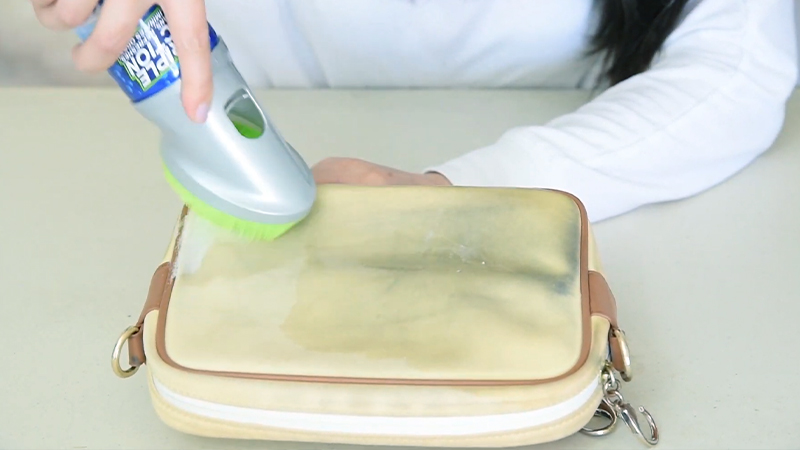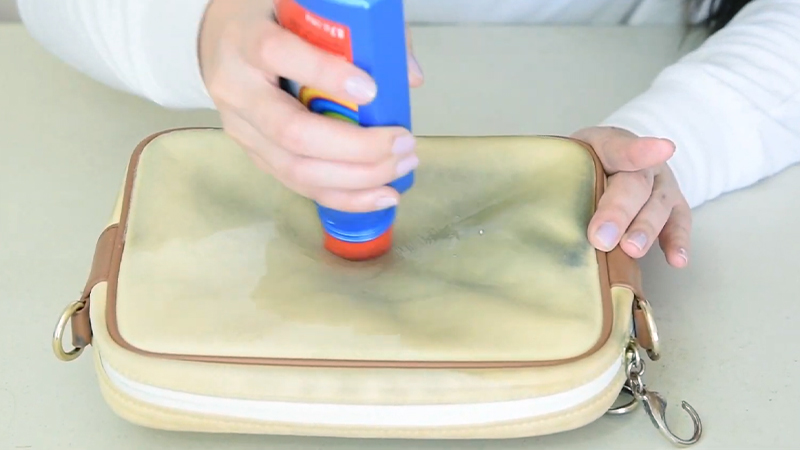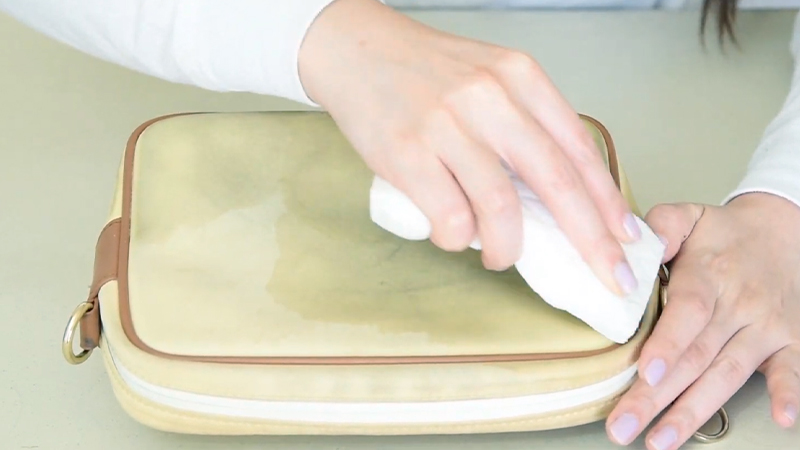Nylon’s resilience makes it a popular choice for a wide range of products, from clothing to carpets. However, even this durable material isn’t impervious to stains.
Whether it’s oil, food, ink, or other substances, knowing how to effectively clean nylon is essential for maintaining its appearance and longevity. In this guide, we’ll delve into proven techniques for tackling various types of stains on nylon.
From gentle detergent solutions to targeted treatments, you’ll learn the steps and precautions necessary to restore your nylon items to their pristine state. Follow these instructions to ensure your nylon possessions remain as vibrant and durable as the day you got them.

How to Clean Nylon Stains?
Nylon is a durable and versatile synthetic material commonly used in various products, including clothing, bags, and carpets.
While nylon is known for its resistance to stains, it’s not entirely immune. Over time, dirt, oil, and other substances can accumulate and create unsightly stains.
Here’s a guide on how to effectively clean nylon stains:
Materials You’ll Need:
- Mild detergent or dish soap
- Warm water
- Soft-bristle brush or sponge
- White vinegar
- Baking soda
- Microfiber cloth or clean towel
- Soft toothbrush
- Rubbing alcohol
- Stain remover
Steps to Clean Nylon Stains:
Identify the Stain Type
Begin by assessing the type of stain you’re dealing with. Understanding the nature of the stain will help you select the most effective cleaning method.
Common stains on nylon include oil, dirt, food, ink, and dye transfer from other fabrics. Identifying the stain type will guide your approach to removing it.
Scrape Away Excess Stain
Before attempting to clean the stain, gently remove any loose or excess material. For example, if you’ve spilled sauce on a nylon shirt, use a spoon or the edge of a dull knife to carefully scrape away any solid residue.
Avoid vigorous rubbing, which could push the stain deeper into the fabric.
Prep the Cleaning Solution
Create a suitable cleaning solution by mixing warm water with a mild detergent or dish soap. Use a ratio of approximately one teaspoon of detergent to one cup of warm water.
For tougher stains, you can enhance the cleaning power by adding a small amount of white vinegar or a pinch of baking soda to the solution.
Test in an Inconspicuous Area
Before applying the cleaning solution directly to the stain, perform a patch test in an inconspicuous area of the nylon fabric. This will help you ensure that the cleaning solution won’t cause color fading or damage to the material.
Clean the Stain
Dip a soft-bristle brush or sponge into the prepared cleaning solution. Gently blot or rub the stained area with the dampened brush or sponge.
Start from the outer edges of the stain and work your way toward the center. Avoid vigorous scrubbing, as this could potentially damage the delicate nylon fibers.
Rinse Thoroughly
After successfully removing the stain, rinse the cleaned area thoroughly with clean, lukewarm water. This step is crucial to eliminate any lingering soap residue. You can use a clean, damp cloth or sponge to wipe away the cleaning solution.
Blot Dry
To remove excess moisture, blot the cleaned area with a clean, dry microfiber cloth or towel. Pat gently instead of rubbing, as rubbing can create friction and potentially harm the nylon fabric.
Treat Stubborn Stains
For persistent or set-in stains, you may need to repeat the cleaning process or try a specialized stain remover designed specifically for nylon materials. Always follow the manufacturer’s instructions carefully when using stain removers.
Address Ink Stains
When you’re dealing with an ink stain on nylon, moisten a soft cloth with rubbing alcohol. Gently blot the stained area with the alcohol-soaked cloth.
It’s important to exercise caution and test a small, inconspicuous area first to ensure that the alcohol won’t damage the nylon.
Air Dry
Allow the cleaned area to air dry completely before using or storing the item. This ensures that any remaining moisture evaporates naturally, leaving your nylon item looking its best.
Post-Cleaning Inspection

After you’ve gone through the process of cleaning nylon stains, it’s crucial to perform a post-cleaning inspection to ensure that the stain has been completely removed and that there’s no damage to the nylon material.
Here’s how you can conduct a thorough post-cleaning inspection:
Check for Residue
Examine the cleaned area for any signs of residue from the cleaning solution. Look closely to ensure there are no soap streaks or leftover cleaning agents. Additionally, inspect for any changes in color or texture that may have occurred during the cleaning process.
Verify Stain Removal
Evaluate the treated area to confirm that the stain has been completely removed. Check from different angles and under various lighting conditions to be certain. If any remnants of the stain persist, you may need to repeat the cleaning process or use a specialized stain remover.
Assess Fabric Integrity
Gently touch and feel the cleaned area to ensure that the fabric’s texture and integrity haven’t been compromised. Nylon is known for its durability, but aggressive scrubbing or the use of harsh chemicals can potentially weaken the fibers.
Look for Color Fading
Check for any signs of color fading or discoloration that may have occurred during the cleaning process. If you notice any changes in color, it’s important to address this promptly, as it could indicate that the cleaning solution was too strong.
Inspect for Loose Threads
Examine the fabric closely for any loose threads or signs of pilling. Aggressive scrubbing or brushing can sometimes cause nylon fibers to fray. If you notice any loose threads, trim them carefully with scissors to prevent further damage.
Evaluate Overall Cleanliness
Take a step back and look at the entire item to ensure that the cleaned area blends seamlessly with the rest of the fabric. There should be no noticeable contrast in terms of cleanliness or texture.
Allow for Final Drying
When you have to rinse the area during the cleaning process, make sure it’s completely dry. This is particularly important if you use a damp cloth or sponge for rinsing.
Follow Up if Necessary
When you discover any issues during the post-cleaning inspection, take appropriate action.
This might involve re-cleaning the area, seeking professional assistance, or applying specialized treatments for color correction or fabric restoration.
Tips for Cleaning Different Types of Stains on Nylon

Cleaning different types of stains on nylon may require specific approaches to ensure successful stain removal.
Here are some tips for cleaning various types of stains on nylon:
Oil and Grease Stains
To tackle oil and grease stains on nylon, start by blotting the stain with a clean paper towel or cloth to absorb excess oil. Apply a small amount of mild detergent or dish soap mixed with warm water.
Gently rub the stain with a soft brush or sponge. Rinse thoroughly with clean water to remove any soap residue. Finally, blot the area dry with a clean towel and allow it to air dry completely.
Food and Beverage Stains
For food and beverage stains, begin by scraping off any solid residue with a dull knife or spoon. Create a mixture of mild detergent and warm water.
Blot the stain with the detergent solution using a clean cloth or sponge. Gently rub the stain in a circular motion. Rinse thoroughly with clean water and blot dry with a clean towel. Allow the nylon to air dry.
Ink Stains
When dealing with ink stains, blot the stain with a paper towel to absorb as much ink as possible. Moisten a soft cloth or cotton ball with rubbing alcohol.
Gently blot the stain, working from the outside toward the center to prevent spreading. Rinse with clean water and blot dry. If the stain persists, repeat the alcohol treatment or try a commercial ink remover designed for fabrics.
Blood Stains
For blood stains, rinse the stain immediately with cold water to remove as much blood as possible. Create a paste by mixing cold water with salt or baking soda.
Apply the paste to the stain and let it sit for about 15 minutes. Gently scrub the stain with a soft brush. Rinse with cold water and repeat the process if needed. Air dry the nylon.
Grass Stains
To tackle grass stains, apply a mixture of water and mild detergent directly to the stain. Gently rub the stain with a soft brush or cloth.
Rinse thoroughly with cold water. If the stain persists, try using a mixture of water and white vinegar, then rinse and air dry.
Dye Transfer Stains
If dye transfer has occurred from another fabric onto your nylon item, act promptly. Mix one part vinegar with two parts cold water.
Blot the dye-stained area with the vinegar solution. Rinse with cold water and blot dry. Repeat as necessary until the dye transfer is gone.
Mildew and Mold Stains
To address mildew or mold stains, mix equal parts white vinegar and water. Apply the solution to the stain and let it sit for a few minutes.
Scrub with a soft brush. Rinse thoroughly with clean water. Consider drying the nylon item outdoors in direct sunlight to help prevent further mold growth.
FAQs
Can I use bleach to clean nylon stains?
It’s not recommended to use bleach on nylon, as it can weaken the fibers and cause color fading. Stick to mild detergents or specific stain removers designed for nylon.
How do I remove ink stains from nylon?
Moisten a soft cloth with rubbing alcohol and blot the ink stain gently. Test in an inconspicuous area first. Rinse with clean water and air dry.
Can I machine wash nylon items with stains?
It’s generally safe to machine wash nylon items, but pre-treat stains before washing. Avoid using hot water, and check care labels for specific instructions.
What should I do if the stain persists after cleaning?
If a stain persists, try repeating the cleaning process or use a specialized stain remover formulated for nylon. Always follow manufacturer instructions.
Are there any precautions for cleaning delicate nylon fabrics?
Delicate nylon requires gentle handling. Use mild detergents, avoid aggressive scrubbing, and test cleaning solutions in inconspicuous areas before treating the stain.
Wrap Up
Mastering the art of cleaning nylon stains is a valuable skill that can extend the life and beauty of your nylon possessions. Whether it’s a stubborn ink blot or an accidental food spill, the key is prompt action and the use of appropriate cleaning techniques.
Remember to test cleaning solutions in inconspicuous areas, follow care label instructions, and exercise caution when dealing with delicate items.
With the right knowledge and care, you can effectively remove stains from nylon and keep your garments, bags, and other nylon products looking their best for years to come.
A little effort in cleaning today can go a long way in preserving your nylon items tomorrow.
Leave a Reply